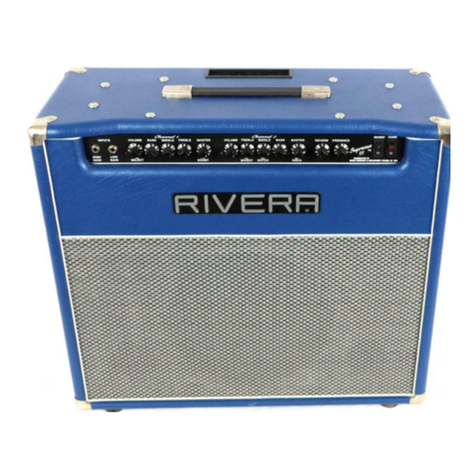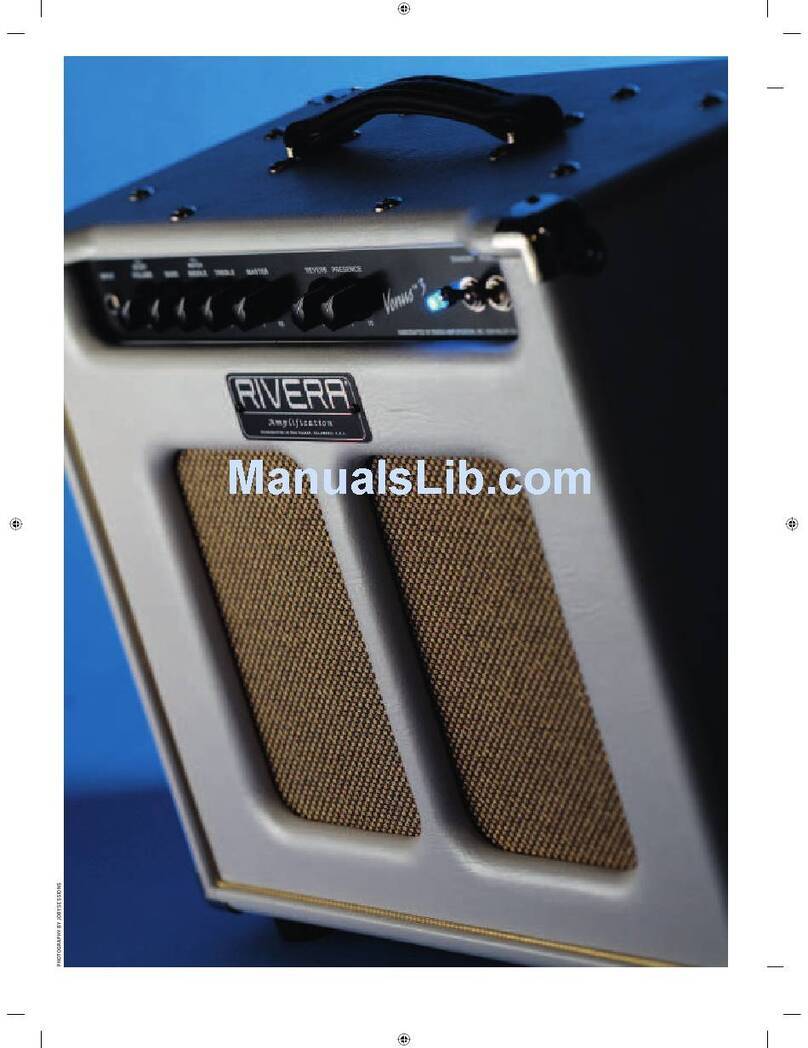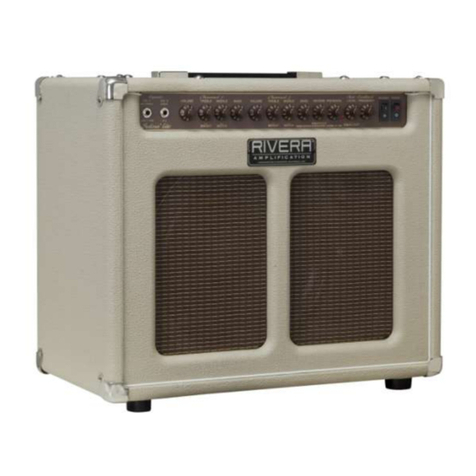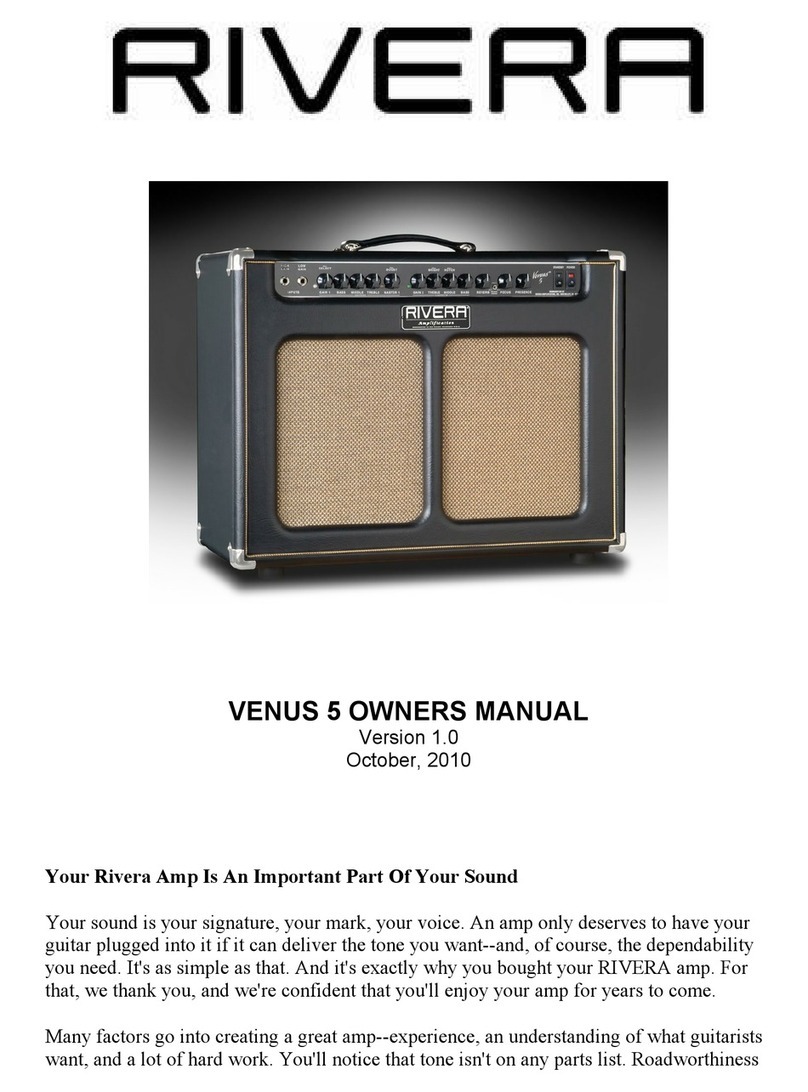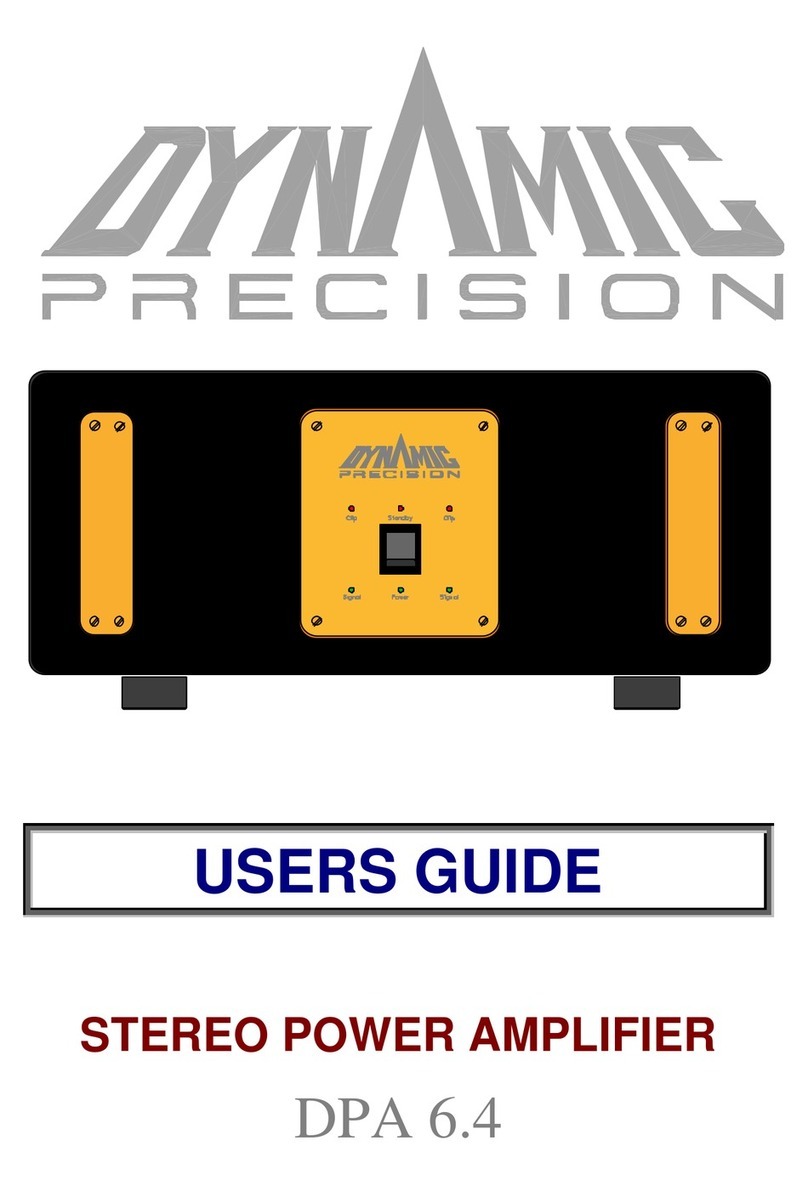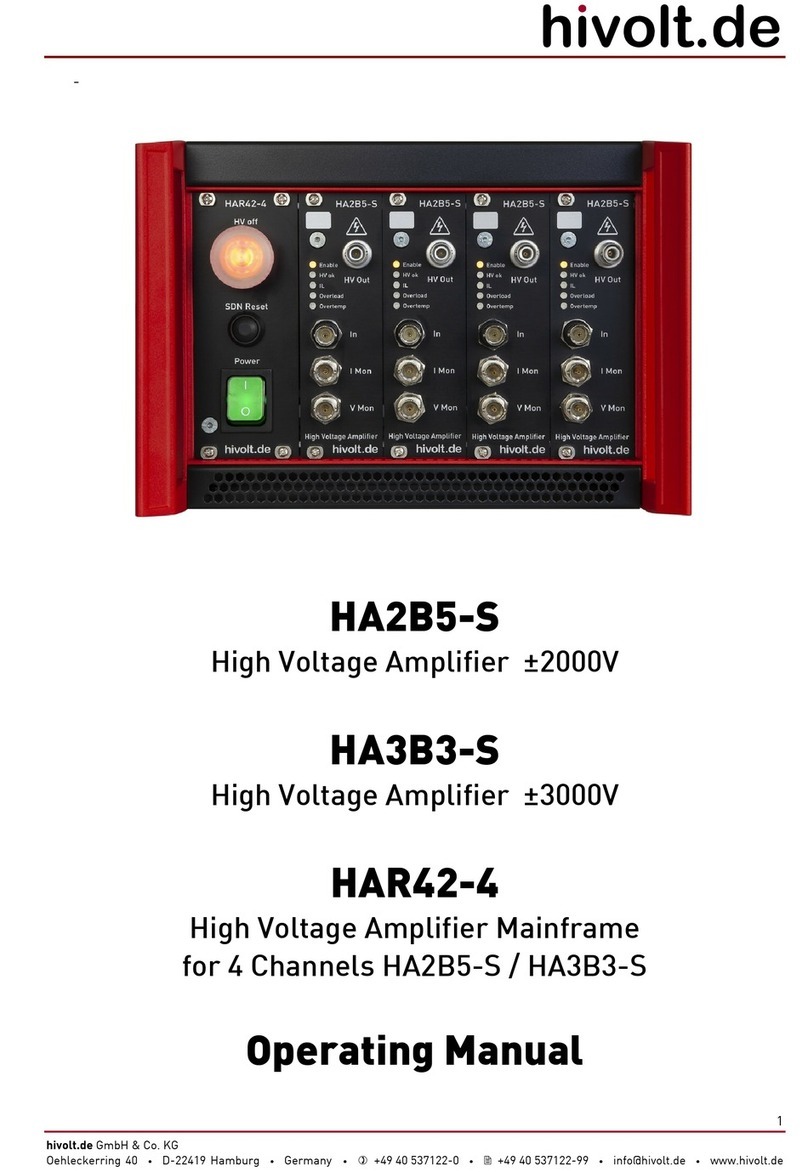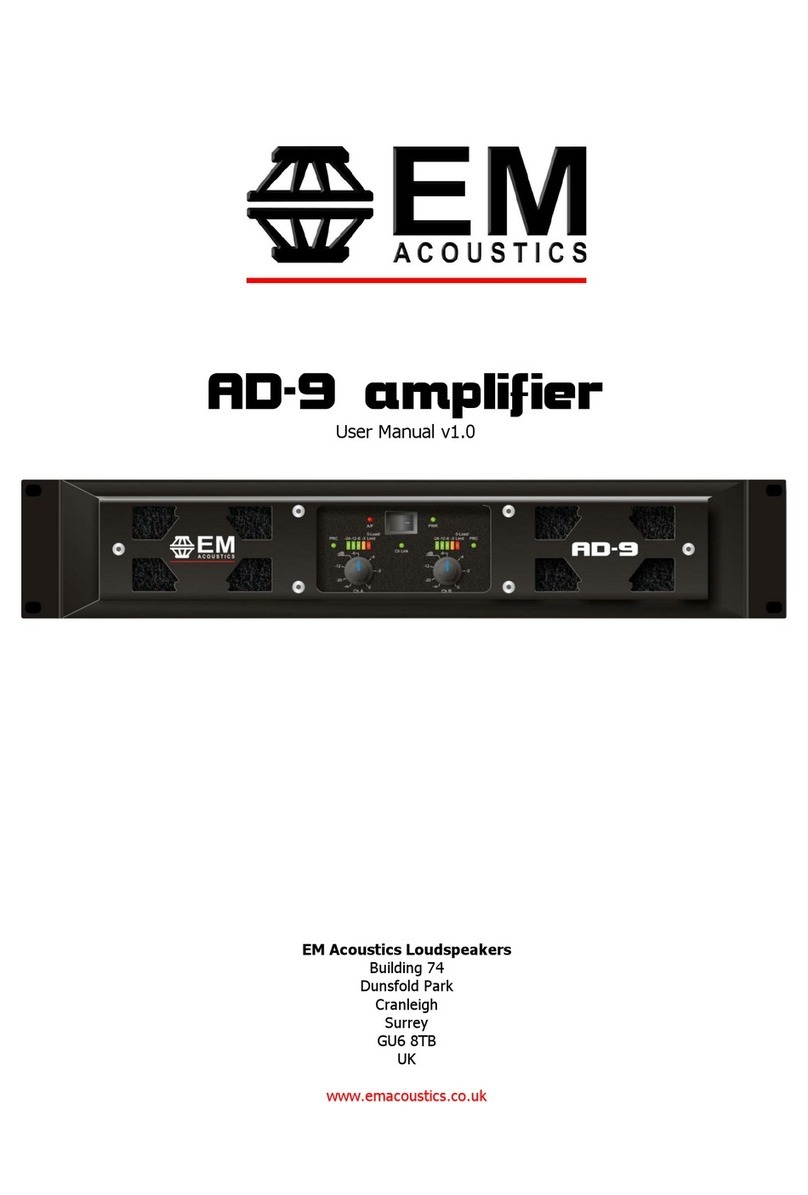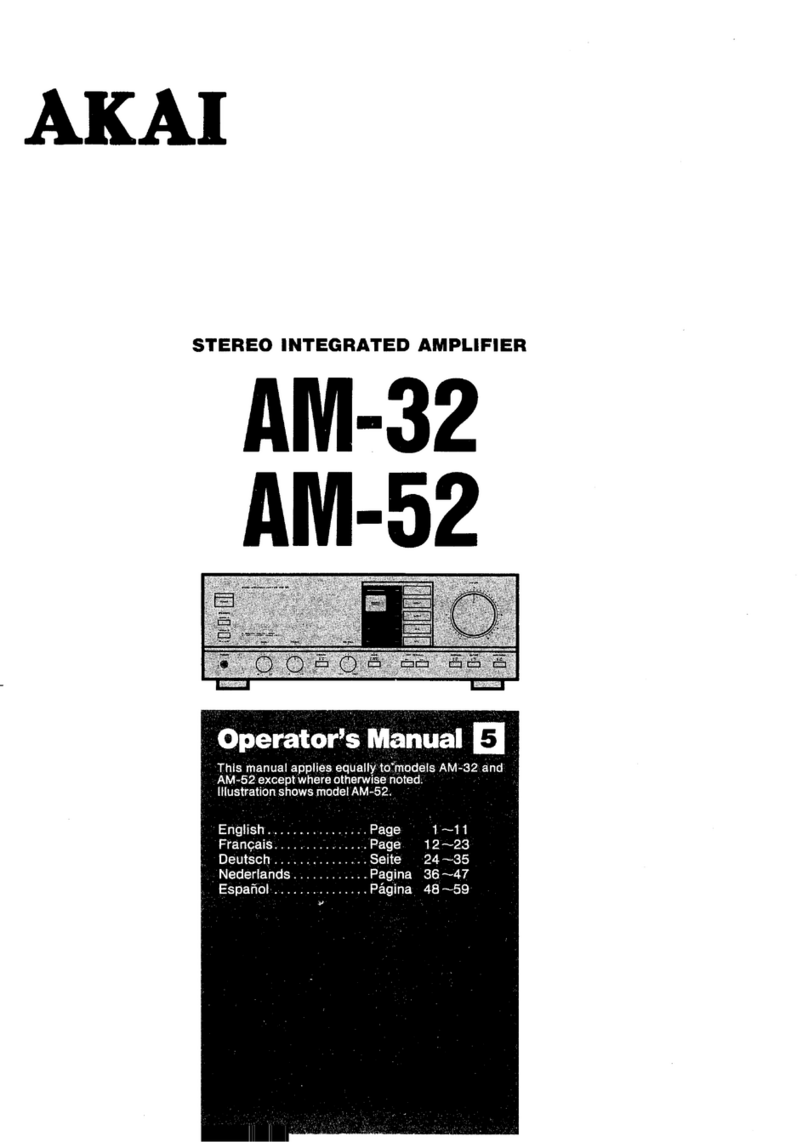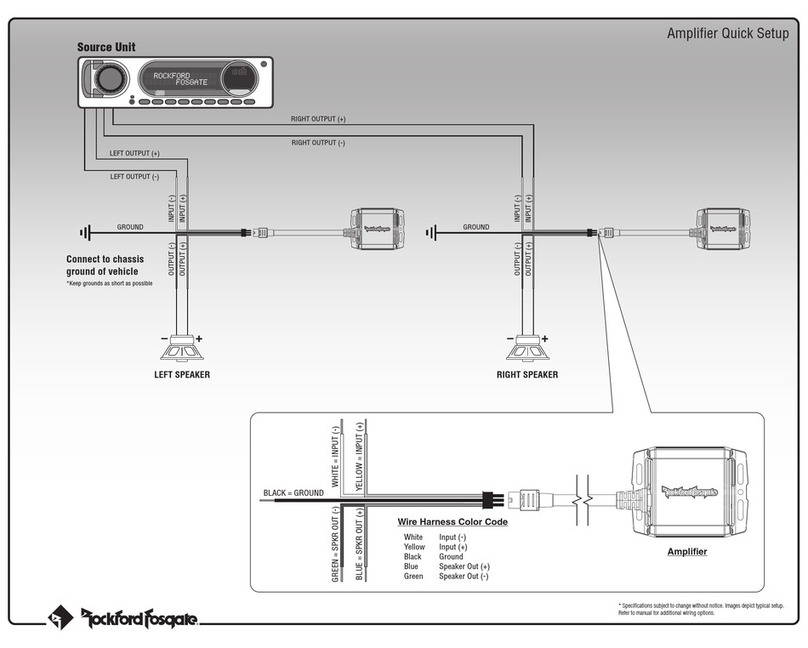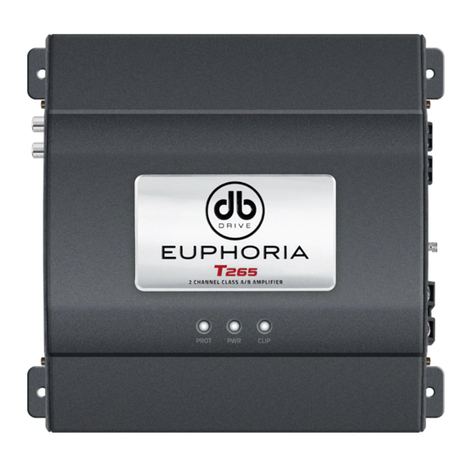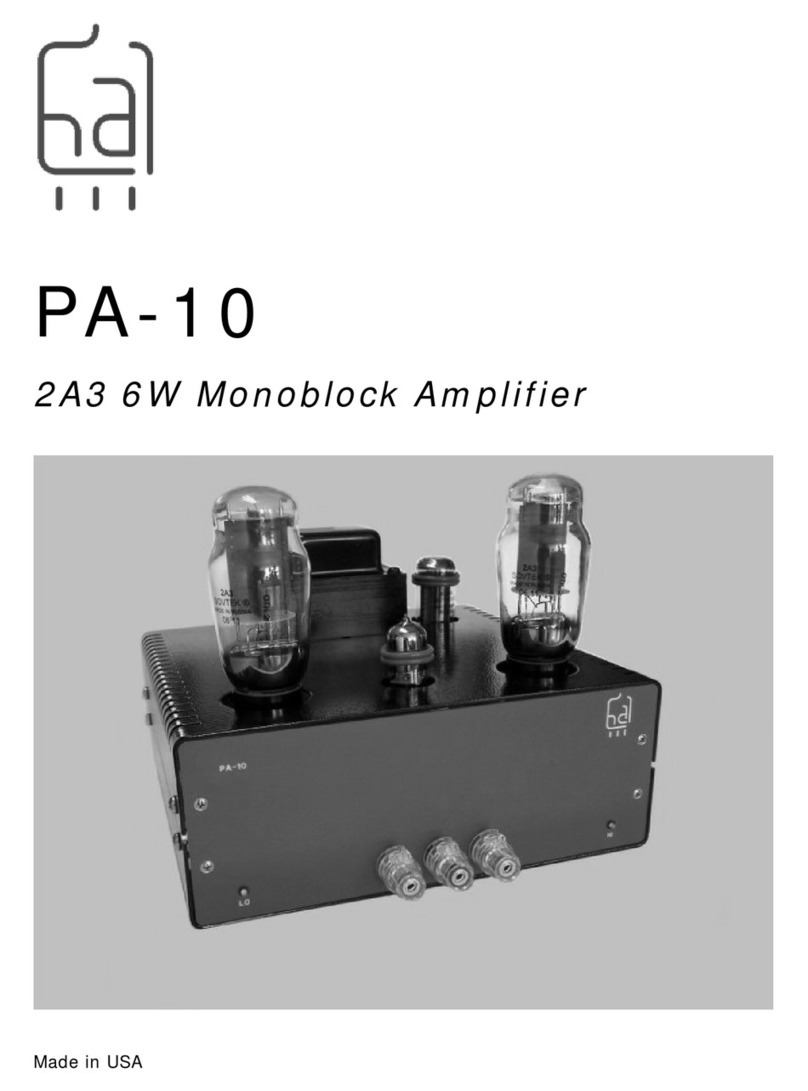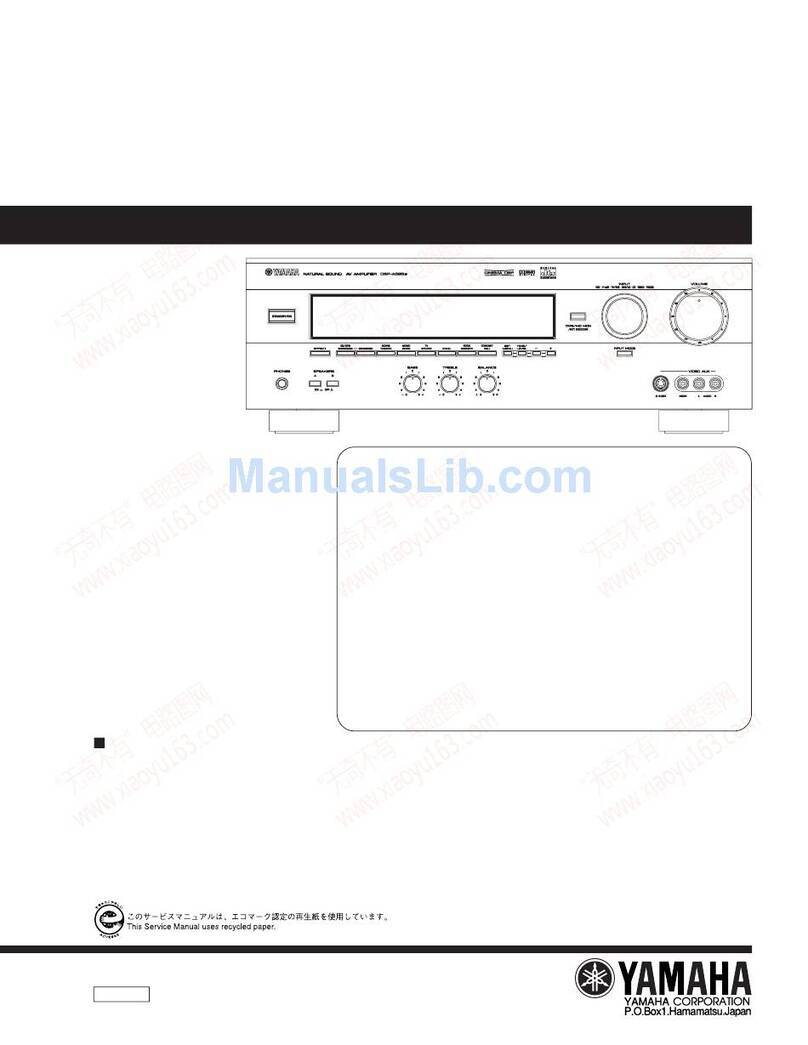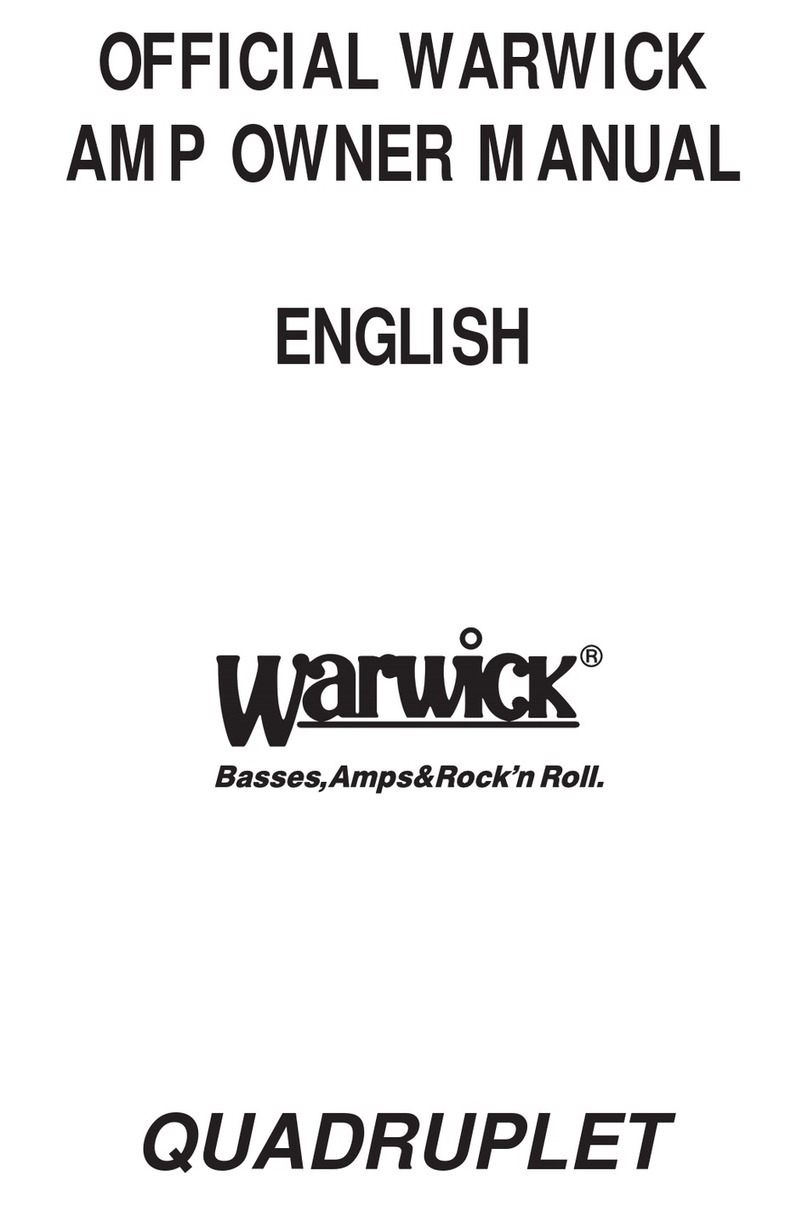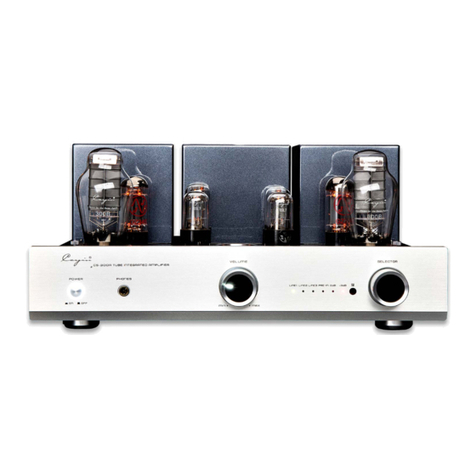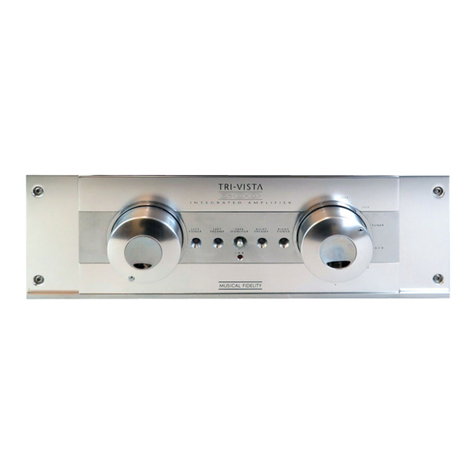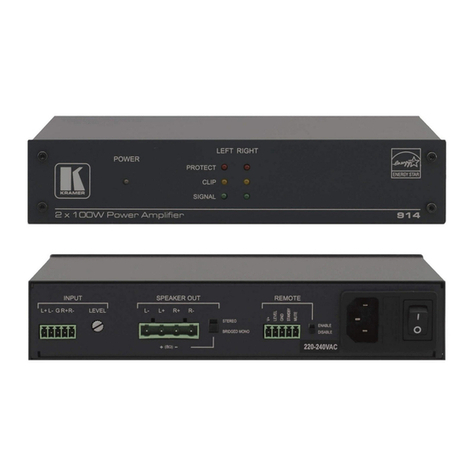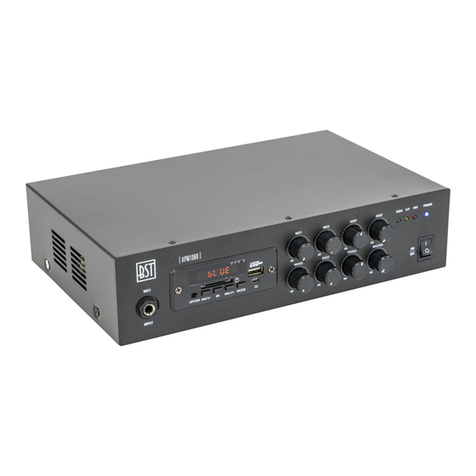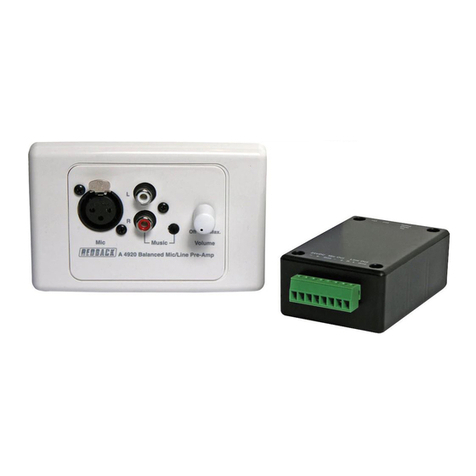Rivera R100-212A User manual

R Series V1.0 p 1
R SERIES
OWNERS MANUAL
Version 1.0
July, 2002

R Series V1.0 p 2
Introduction
Your Rivera Amp Is An Important Part Of Your Sound
Your sound is your signature, your mark, your voice. An amp only deserves to have
your guitar plugged into it if it can deliver the tone you want--and, of course, the
dependability you need. It's as simple as that. And it's exactly why you bought your
RIVERA amp. For that, we thank you, and we're confident that you'll enjoy your amp for
years to come.
Many factors go into creating a great amp--experience, an understanding of what
guitarists want, and a lot of hard work. You'll notice that tone isn't on any parts list.
Roadworthiness isn't, either. And there's no law saying that an amp must sound good or
be well-made. But we dedicate ourselves to making the best-sounding, most reliable
amplifiers anywhere. That's why we use only the highest-quality components,
regardless of price. Such features as metal jacks, ultra-strong dadoed cabinet
construction, and highest-quality electronic components are part of our uncompromising
approach. They're chosen for their precision, strength, and ability to withstand the rigors
of years of use--and occasional abuse--on the stage and in the studio. No compromises
are made because cutting any corners--no matter how small--means settling for second
best.
This requires dedication to you, the guitarist, and a belief that an amp is more than a
collection of parts. It's part of your sound.
Please fill in the following information for future reference:
Model Name:
Model Number:
Serial Number:
Dealer's Name:
Dealer's Address:
Date of Purchase:
RIVERA
13310 Ralston Ave.
Sylmar, CA 91342 USA
Phone: (818) 833-7066
Fax: (818) 833-9656

R Series V1.0 p 3
Packing Information
Unpacking
Before you plug in, inspect your R Series or Custom shop amp for any damage. Your
amp was inspected and sound-tested before shipment, but transportation can
sometimes be tough. Check that the FS-7 Footswitch and power cord have been
shipped with the amp. If parts are missing, or if any damage has occurred, contact your
dealer.
Packing Materials
We designed the original box and packing materials to protect your amp during
shipment. Save them. If you ever need to send your amp to us or to anyone else, the
original box and packing materials will ensure safe transit.
Safety
Throughout this manual, the lightning flash with an arrowhead symbol
within a triangle is intended to alert you to the presence of un-insulated
"dangerous voltages" within the product's enclosure that may be of
sufficient magnitude to constitute a risk of electric shock to persons.
Warning: There are no user-serviceable parts inside of this amplifier.
Warning: To avoid the risk of shock or fire, do not expose this amplifier to moisture. Do
not remove the chassis from its cabinet, or remove metal covers from chassis parts.
Removing the chassis from its cabinet exposes extremely dangerous high voltages.
There are no user-serviceable parts inside. Hazardous voltages are present inside the
chassis. Refer all servicing to qualified personnel.
The exclamation point within a triangle is intended to alert the user to
the presence of important operating and maintenance (servicing)
instructions in the literature that accompanies the product.
Caution: To avoid a fire hazard, always replace the fuses with the same type and
rating.
Caution: Always replace the line cord (mains supply) with the proper type.
Caution: Always turn off the amplifier before making or unplugging any speaker
connections.
Always transport your amplifier securely, preferably in a suitable flight case or packing
carton. Before operating your amplifier, be sure the speakers used are properly
connected. For countries where 220 to 240 volts AC is encountered, make sure that you

R Series V1.0 p 4
have the correct power cord. Our 230-volt export unit can be used with any of these
voltages. For Japan 100VAC models, all instructions for the 115VAC models apply. For
some markets that experience high Mains voltages, a special 250VAC version is
available.
In the event that you have questions, comments, or suggestions, please contact us at:
RIVERA
13310 Ralston Ave.
Sylmar, CA 91342 USA
Phone: (818) 833-7066
Fax: (818) 833-9656
No Time To Read This Manual? At Least Read This Part Now!
Before you plug in:
Take a quick look inside the back of your amp. Make sure of the following--
1. The tubes are securely seated in their sockets (see information on checking for loose
tubes).
2. The internal speaker's cord is plugged into the Speaker 1 output (this jack must
always be used first).
3. The power cord is plugged in.
4. The FS-7 footswitch is plugged in (this is optional).
Now look at the front to make sure:
1. The Volume and Master controls are set at low levels (2 is a good starting point).
2. The Power switch is off (the lower half is pushed in).
3. The Standby switch is set to standby mode (the lower half is pushed in-not applicable
for the R30).
Plug in!
Now plug the amp into the wall, plug your guitar into either input jack, and set your
controls to one of the Quick Start settings outlined here. Then turn on the Power switch.
Wait for about a minute for the tubes to warm up. Turn on the Standby switch. Now it's
time to rock.
After you've played with your Rivera for a while, check out the rest of the manual for
some good tips on getting the most out of your amp.

R Series V1.0 p 5
Quick Start Settings
If you're looking for a good starting point, try these settings. Remember that every guitar
sounds different, so try both inputs, and adjust the reverb and presence to suit your
taste.
VOLUME BASS MIDDLE TREBLE MASTER VOLUME TREBLE MIDDLE BASS MASTER REVERB
TOTASTE
PRESENCE
BRIGHT NOTCH
PULLED PULLED
NINJA
BOOST
SELECT
PULL PULL PULL PULL PULL
1
2
3
4
5
6
7
8
9
10
1
2
3
4
5
6
7
8
9
10
1
2
3
4
5
6
7
8
9
10
1
2
3
4
5
6
7
8
9
10
1
2
3
4
5
6
7
8
9
10
1
2
3
4
5
6
7
8
9
10
1
2
3
4
5
6
7
8
9
10
1
2
3
4
5
6
7
8
9
10
1
2
3
4
5
6
7
8
9
10
1
2
3
4
5
6
7
8
9
10
1
2
3
4
5
6
7
8
9
10
1
2
3
4
5
6
7
8
9
10
Input: Low Gain
Ch 1: Clean
Ch 2: Clean comping
VOLUME BASS MIDDLE TREBLE MASTER VOLUME TREBLE MIDDLE BASS MASTER REVERB
TOTASTE
PRESENCE
BRIGHT NOTCH
PULLED PULLED
NINJA
BOOST
SELECT
PULL PULL PULL PULL PULL
1
2
3
4
5
6
7
8
9
10
1
2
3
4
5
6
7
8
9
10
1
2
3
4
5
6
7
8
9
10
1
2
3
4
5
6
7
8
9
10
1
2
3
4
5
6
7
8
9
10
1
2
3
4
5
6
7
8
9
10
1
2
3
4
5
6
7
8
9
10
1
2
3
4
5
6
7
8
9
10
1
2
3
4
5
6
7
8
9
10
1
2
3
4
5
6
7
8
9
10
1
2
3
4
5
6
7
8
9
10
1
2
3
4
5
6
7
8
9
10
Input: Either
Ch 1: Overdrive with mids sucked out
Ch 2: Blues Crunch
VOLUME BASS MIDDLE TREBLE MASTER VOLUME TREBLE MIDDLE BASS MASTER REVERB
TOTASTE
PRESENCE
BRIGHT NOTCH
PULLED PULLED
NINJA
BOOST
SELECT
PULL PULL PULL PULL PULL
1
2
3
4
5
6
7
8
9
10
1
2
3
4
5
6
7
8
9
10
1
2
3
4
5
6
7
8
9
10
1
2
3
4
5
6
7
8
9
10
1
2
3
4
5
6
7
8
9
10
1
2
3
4
5
6
7
8
9
10
1
2
3
4
5
6
7
8
9
10
1
2
3
4
5
6
7
8
9
10
1
2
3
4
5
6
7
8
9
10
1
2
3
4
5
6
7
8
9
10
1
2
3
4
5
6
7
8
9
10
1
2
3
4
5
6
7
8
9
10
Input: Either
Ch 1: SRV Grind
Ch 2: Gonzo lead

R Series V1.0 p 6
Front Panel
INPUTS VOLUME BASS MIDDLE TREBLE MASTER VOLUME TREBLE MIDDLE BASS MASTER REVERB PRESENCE
STANDBY
POWER
HANDCRAFTED BY RIVERA RESEARCH & DEVELOPMENT
SYLMAR, CA USA
BRIGHT NOTCH NINJA
BOOST
SELECTGAIN
GAIN
HIGH LOW
PULL PULL PULL PULL PULL
1
2
3
4
5
6
7
8
9
10
1
2
3
4
5
6
7
8
9
10
1
2
3
4
5
6
7
8
9
10
1
2
3
4
5
6
7
8
9
10
1
2
3
4
5
6
7
8
9
10
1
2
3
4
5
6
7
8
9
10
1
2
3
4
5
6
7
8
9
10
1
2
3
4
5
6
7
8
9
10
1
2
3
4
5
6
7
8
9
10
1
2
3
4
5
6
7
8
9
10
1
2
3
4
5
6
7
8
9
10
1
2
3
4
5
6
7
8
9
10
INPUTS VOLUME BASS MIDDLE TREBLE MASTER VOLUME TREBLE MIDDLE BASS MASTER REVERB
POWER
HANDCRAFTED BY RIVERA RESEARCH & DEVELOPMENT
SYLMAR, CA USA
NOTCH NINJA
BOOST
SELECTGAIN
GAIN
HIGH LOW
PULL PULL PULL PULL
1
2
3
4
5
6
7
8
9
10
1
2
3
4
5
6
7
8
9
10
1
2
3
4
5
6
7
8
9
10
1
2
3
4
5
6
7
8
9
10
1
2
3
4
5
6
7
8
9
10
1
2
3
4
5
6
7
8
9
10
1
2
3
4
5
6
7
8
9
10
1
2
3
4
5
6
7
8
9
10
1
2
3
4
5
6
7
8
9
10
1
2
3
4
5
6
7
8
9
10
1
2
3
4
5
6
7
8
9
10
INPUTS VOLUME BASS MIDDLE TREBLE MASTER VOLUME TREBLE MIDDLE BASS MASTER REVERB PRESENCE
STANDBY
POWER
HANDCRAFTED BY RIVERA RESEARCH & DEVELOPMENT
SYLMAR, CA USA
BRIGHT NOTCH NINJA
BOOST
SELECTGAIN
GAIN
HIGH LOW
PULL PULL PULL PULL PULL
1
2
3
4
5
6
7
8
9
10
1
2
3
4
5
6
7
8
9
10
1
2
3
4
5
6
7
8
9
10
1
2
3
4
5
6
7
8
9
10
1
2
3
4
5
6
7
8
9
10
1
2
3
4
5
6
7
8
9
10
1
2
3
4
5
6
7
8
9
10
1
2
3
4
5
6
7
8
9
10
1
2
3
4
5
6
7
8
9
10
1
2
3
4
5
6
7
8
9
10
1
2
3
4
5
6
7
8
9
10
1
2
3
4
5
6
7
8
9
10
INPUTS VOLUME BASS MIDDLE TREBLE MASTER VOLUME TREBLE MIDDLE BASS MASTER REVERB PRESENCE
STANDBY
POWER
RIVERA RESEARCH & DEVELOPMENT SYLMAR, CA USA
HANDCRAFTED BY
TM
BRIGHT NOTCH NINJA
BOOST
SELECTGAIN
GAIN
HIGH LOW PULL PULL PULL PULL PULL
1
2
3
4
5
6
7
8
9
10
1
2
3
4
5
6
7
8
9
10
1
2
3
4
5
6
7
8
9
10
1
2
3
4
5
6
7
8
9
10
1
2
3
4
5
6
7
8
9
10
1
2
3
4
5
6
7
8
9
10
1
2
3
4
5
6
7
8
9
10
1
2
3
4
5
6
7
8
9
10
1
2
3
4
5
6
7
8
9
10
1
2
3
4
5
6
7
8
9
10
1
2
3
4
5
6
7
8
9
10
1
2
3
4
5
6
7
8
9
10
INPUTS VOLUME BASS MIDDLE TREBLE MASTER VOLUME TREBLE MIDDLE BASS MASTER REVERB PRESENCE
STANDBY
POWER
RIVERA RESEARCH & DEVELOPMENT SYLMAR, CA USA
HANDCRAFTED BY
TM
BRIGHT NOTCH NINJA
BOOST
SELECTGAIN
GAIN
HIGH LOW PULL PULL PULL PULL PULL
1
2
3
4
5
6
7
8
9
10
1
2
3
4
5
6
7
8
9
10
1
2
3
4
5
6
7
8
9
10
1
2
3
4
5
6
7
8
9
10
1
2
3
4
5
6
7
8
9
10
1
2
3
4
5
6
7
8
9
10
1
2
3
4
5
6
7
8
9
10
1
2
3
4
5
6
7
8
9
10
1
2
3
4
5
6
7
8
9
10
1
2
3
4
5
6
7
8
9
10
1
2
3
4
5
6
7
8
9
10
1
2
3
4
5
6
7
8
9
10
INPUTS VOLUME BASS MIDDLE TREBLE MASTER VOLUME TREBLE MIDDLE BASS MASTER REVERB PRESENCE
STANDBY
POWER
RIVERA RESEARCH & DEVELOPMENT SYLMAR, CA USA
HANDCRAFTED BY
TM
BRIGHT NOTCH NINJA
BOOST
SELECTGAIN
GAIN
HIGH LOW PULL PULL PULL PULL PULL
1
2
3
4
5
6
7
8
9
10
1
2
3
4
5
6
7
8
9
10
1
2
3
4
5
6
7
8
9
10
1
2
3
4
5
6
7
8
9
10
1
2
3
4
5
6
7
8
9
10
1
2
3
4
5
6
7
8
9
10
1
2
3
4
5
6
7
8
9
10
1
2
3
4
5
6
7
8
9
10
1
2
3
4
5
6
7
8
9
10
1
2
3
4
5
6
7
8
9
10
1
2
3
4
5
6
7
8
9
10
1
2
3
4
5
6
7
8
9
10
High Gain input
This is a high-sensitivity input. If your guitar has hot pickups, then plugging into it makes
it easy to overdrive the preamp section, creating harmonic distortion. Guitars equipped
with low-output pickups seem hotter than usual when plugged into this input.
Low Gain input
This is a low-sensitivity input. Guitars plugged into it have more headroom before
distortion sets in (meaning that you can crank up a channel's volume a little louder
before you experience preamp distortion). This is a good choice for a clean overall
sound, and is especially well-suited to active pickups or guitars equipped with preamps.
Channel 1
Both channels are voiced differently, and Channel 1 is definitely geared toward creating
impressive overdrive (think of a "British" tone). Grit, grunge, dirt--whatever you're
looking for in the distortion department is here, from sweet and singing to hard-driving to
maximum sustain. Note: Like the controls on all classic amps, the Treble, Middle, and
Bass interact, creating smooth, musical tone changes. All three controls operate with
even response throughout their ranges.

R Series V1.0 p 7
Volume (with channel-select switch)
Although it's labeled "Volume," this control does a lot more than determine how loud
Channel 1 is. It regulates the preamp's volume and works with the Master to set the
level and distortion amount. A simple rule of thumb is, the higher the Volume is set, the
more distortion you get. The pull switch selects which channel is active. Its circuitry is
designed so that you don't hear a pop or click when the channel is changed. (The FS-7
footswitch also selects channels; the Volume's pull switch must be pushed in for the FS-
7 to choose channels. See the later section on the FS-7 and its functions.)
Bass
The "chunk" and support that form the backbone of your tone come from this control. Its
effect on your overall sound will be different at high and low volumes due to the
speaker's characteristics and how much distortion you use.
Middle
The midrange circuit provides the "meat" that fills out your sound. It has a slight notch in
the frequency spectrum at about 550 Hz, and turning the knob alters the depth of that
notch, letting you change the overall voicing of your tone.
Treble
Whether you're looking for edge, slash, or just a little shimmer, this knob's for you. Like
the Bass control, the apparent effect of the Treble changes with the loudness and
distortion you dial in.
Master (with Pull Boost switch)
Think of the Master as a sort of governor that sets the maximum loudness for the
channel. Also, think of it as the second half of what the Volume knob does. With the
Volume turned down and the Master up, there's less distortion than if you crank up the
Volume and set the Master lower. The Master control comes after all distortion and
tone-shaping on Channel 1, so its level doesn't have a bearing on your basic tone.
When you pull out the Boost switch on Channel 1, it adds a whole range of harmonics,
and not just gain. This is easy to hear by playing a power chord and comparing its
sound with the switch pushed in and pulled out. With the switch activated, the tone
blooms, going from fat to ferocious.
Channel 2
Channel 2 is extremely flexible, with a flavor that brings to mind the great classic
American tones and textures. You can get some pretty impressive lead overdrive
distortion out of Channel 2, and as a rhythm channel it brings out every subtlety of your
playing. The range of tones can be anywhere from sparkling-clean to perfect for bluesy
rhythm--the kind of sound that has an attitude and gets meaner as you pick harder.
Volume
The Volume knob regulates the preamp's volume and works with the Master to set the
level and distortion amount. A simple rule of thumb is, the higher the Volume is set, the
more distortion you get.
Treble - Chubster, Suprema, R55-112, and R100-212 include Pull Bright switch
This treble control is similar in operation to the one on Channel 1. In addition, it has a
built-in Pull Bright switch. When pulled out, it adds bright highlights to the tone.

R Series V1.0 p 8
Middle (with Pull Notch switch)
The midrange circuit has a slight notch in the frequency spectrum at about 550 Hz, and
turning the knob alters the depth of that notch. Its Pull Notch switch shifts the frequency
center of that notch down to about 250 Hz. (For reference, most 1950s tweed amps
have their notch centered at 550 Hz, while classic "blackface" amps have theirs
centered at 250 Hz.) Experiment with this, especially if you're looking for a uniquely
expressive rhythm texture.
Bass
The "chunk" and support that form the backbone of your tone come from this control.
Master (with Pull Ninja switch)
Channel 2 has a special EQ circuit that works in conjunction with the distortion circuit to
sweeten the tone. Therefore, the Master knob's effect goes beyond loudness control.
Try it with different Volume and Middle settings to adjust the amount of "singing" and
"grit." The Ninja Boostª, activated by pulling out the Master knob, is a sweet-sounding
boost characterized by a more subtle effect on the harmonics than Channel 1's Boost
control while adding sustain. The Ninja Boost helps to drive the power amp, and the
best description of its influence over the tone is that it thickens it.
Reverb
In the tradition of classic amps, your R Series amp is equipped with a spring reverb. Its
single-knob operation controls its effect on the signal coming from both preamp
channels. Specially buffered circuitry drives the reverb, keeping your tone intact and
minimizing harshness.
Presence - Chubster, Suprema, R55-112, and R100-212
The Presence control is incorporated as a vital part of the power amp section. Think of it
as a final brightness control after all the EQ, distortion, effects, and reverb.
Standby - Chubster, Suprema, R55-112, and R100-212
By turning the Power on and the Standby off (the down position, labeled with a "0"), you
can warm up the amplifier before applying full voltage to the preamp and power output
tubes. This prolongs tube life. Using the Standby switch when you're taking a break also
helps to extend the tubes' life, plus it keeps the amp constantly at the ready. Just flip the
Standby switch to the up ("I") position, and you're ready to play.
Power
This is your main power switch. The on position is indicated by the light being
illuminated. The off position is marked by the "0" on the switch. Before turning the amp
on, always check that a speaker is connected and that the power cord is firmly plugged
into the amp and the outlet.

R Series V1.0 p 9
Rear Panel
F
U
S
E
F
U
S
E
TO REDUCETHE RISK OF
ELECTRIC SHOCK,
DO NOT REMOVE CHASSIS
CAUTION
REPLACE FUSEWITH SAME TYPE AND RATING
MAINS
INPUT POWER
180WATTS
MAINS INPUT
FUSE
2A 250V
115V ~ 60Hz
SLO-BLO
CHUBSTER 40
MODEL WARNING:TO REDUCE THE RISK OF FIRE
OR ELECTRIC SHOCK, DO NOT EXPOSE
THIS EQUIPMENTTO RAIN OR MOISTURE
SERIAL NUMBER
RIVERA RESEARCH & DEVELOPMENT SYLMAR, CALIFORNIA, USA
LINE OUT
560 Ω
FOOTSWITCH
USE FS-7 ONLY POWER AMP PREAMP
OUT
PATCH
IN
TOTAL MIN. Z 8 Ω
40 W. RMS
CAUTION:CHASSIS SURFACE HOT
CAUTION:NO USER SERVICEABLE PARTS INSIDE. REFER SERVICINGTO QUALIFIED PERSONNEL
SPEAKER
F
U
S
E
F
U
S
E
F
U
S
E
F
U
S
E
TO REDUCETHE RISK OF
ELECTRIC SHOCK,
DO NOT REMOVE CHASSIS
REPLACE FUSEWITH SAME TYPE AND RATING
MAINS
INPUT POWER
300WATTS
MAINS INPUT
FUSE
H.T.
FUSE
3A 250V
115V ~ 60Hz
SLO-BLO
500MA 250V
SLO-BLO
WARNING:TO REDUCE THE RISK OF FIRE
OR ELECTRIC SHOCK, DO NOT EXPOSE
THIS EQUIPMENTTO RAIN OR MOISTURE
SERIAL NUMBER
MODEL R55-12
RIVERA RESEARCH & DEVELOPMENT CORP., SYLMAR, CALIFORNIA, USA
LINE OUT
560 Ω
Z IN
250K ΩZ OUT
560 Ω
FOOTSWITCH
USE FS-7 ONLY RETURN
RETURN
LEVEL LEVEL
SEND
SEND
EFFECTS LOOP
TOTAL MIN. Z 8 Ω 55 W. RMS
SPEAKER JACKS IN PARALLEL
USE FIRST
CAUTION:CHASSIS SURFACE HOT
CAUTION:NO USER SERVICEABLE PARTS INSIDE. REFER SERVICINGTO QUALIFIED PERSONNEL
SPEAKER 1
SPEAKER 2
1
2
3
4
5
6
7
8
9
10
1
2
3
4
5
6
7
8
9
10
CAUTION
F
U
S
E
F
U
S
E
F
U
S
E
F
U
S
E
SHOCK,DO NOT REMOVE CHASSIS
TO REDUCETHE RISK OF ELECTRIC
REPLACE FUSEWITH SAME TYPE AND RATING
MAINS
INPUT POWER
400WATTS
MAINS INPUT
FUSE
H.T.
FUSE
4A 250V
115V ~ 60Hz
SLO-BLO
1A 250V
SLO-BLO
WARNING:TO REDUCE THE RISK OF FIRE
OR ELECTRIC SHOCK, DO NOT EXPOSE
THIS EQUIPMENTTO RAIN OR MOISTURE
SERIAL NUMBER
MODEL
HUNDRED DUOTWELVE
RIVERA RESEARCH & DEVELOPMENT CORP., SYLMAR, CALIFORNIA, USA
LINE OUT
560 Ω
Z IN
250K ΩZ OUT
560 Ω
FOOTSWITCH
USE FS-7 ONLY
RETURN
RETURN
LEVEL LEVEL
SEND
SEND
EFFECTS LOOP
TOTAL MINIMUM Z 4 Ω
100 WATTS RMS
SPEAKER JACKS
IN PARALLEL
USE FIRST
CAUTION: CHASSIS SURFACE HOT
CAUTION: NO USER SERVICEABLE PARTS INSIDE. REFER SERVICING TO QUALIFIED PERSONNEL
SPEAKER 1
SPEAKER 2
1
2
3
4
5
6
7
8
9
10
1
2
3
4
5
6
7
8
9
10
CAUTION
Mains Input
Your R Series amp has a detachable power cord that connects to the chassis AC
connector labeled Mains Input. Always use this cord and, in the event that the power
cord requires replacement, replace it with the same type of power cord. Consult your
RIVERA dealer for further information. Be sure to use a grounded electrical mains
power supply socket whenever possible. These outlets have a grounding pin in addition
to the normal line and neutral pin. The power cord supplied with your R Series amp has
a 3-pin plug. Do not cut off or damage the ground pin. If the available electrical outlet is
of the older 2-pin type, use a suitable ground-lift adapter.
The U.S.A., Canada, and Japan share a common CSA/UL-style cord. Most of Europe
and Scandinavia utilize a Euro plug and have a SEMKO/VDE-style cord. Australia uses
a different type of plug, as does the United Kingdom.
Note: Avoid using long extension cords. Long cords have sufficient
resistance to electrical current that the voltage arriving at your amp can
be significantly reduced. This can have a bad effect on your tone.
Mains Fuse
This AC line fuse protects your amplifier from damage due to shorts, momentary
surges, and defective power tubes. In the event of a fuse failure, always replace it with
the same type of fuse.
Mains Fuse - R30-112, and Chubster 40
For 100VAC and 115VAC versions, the Mains Fuse is:
2 Amp, 250 Volt Slo-Blo type (size 3AG, or MDL)
For 230VAC versions, the Mains Fuse is:
T 800mA (time-delay, 5mm x 20mm size)

R Series V1.0 p 10
Mains Fuse - R55-112, Suprema, and Chubster 55
For 100VAC and 115VAC versions, the Mains Fuse is:
3 Amp, 250 Volt Slo-Blo type (size 3AG, or MDL)
For 230VAC versions, the Mains Fuse is:
T 1.25A (time-delay, 5mm x 20mm size)
Mains Fuse - R100-212
For 100VAC versions, the Mains Fuse is:
5 Amp, 250 Volt Slo-Blo type (size 3AG, or MDL)
For 115VAC versions, the Mains Fuse is:
4 Amp, 250 Volt Slo-Blo type (size 3AG, or MDL)
For 230VAC versions, the Mains Fuse is:
T 2A (time-delay, 5mm x 20mm size)
Note: Always turn the amp off and wait about five minutes before
replacing a fuse. This allows the parts to cool and high voltages to
dissipate.
HT Fuse - Chubster 55, Suprema, R55-112 and R100-212
The power amplifier circuit has its own fuse for protecting the output section from short
circuits and transient current peaks that exceed the normal current draw. These
conditions are usually caused by a bad Output (EL-34) tube. When a short circuit or
transient peak causes the fuse to blow, the output tubes should be checked and
replaced, if necessary.
HT Fuse - Chubster 55, Suprema, R-55-112
For 100VAC and 115VAC versions, the HT Fuse is:
1/2 Amp, 250 Volt Slo-Blo type (3AG, or MDL)
For 230VAC versions, the HT Fuse is:
T 500mA (time-delay, 5mm x 20mm size)
HT Fuse - R100-212
For 100VAC and 115VAC versions, the HT Fuse is:
1 Amp, 250 Volt Slo-Blo type (3AG, or MDL)
For 230VAC versions, the HT Fuse is:
T 1A (time-delay, 5mm x 20mm size)

R Series V1.0 p 11
Note: Repeated blowing of this fuse is a clear indicator of a defective
output tube(s). Always use the correct fuse value when replacing the
HT Fuse.
If the Mains Fuse or the HT Fuse repeatedly blows, refer your amp to your local
RIVERA dealer or contact us at (818) 833-7066 for further service assistance.
Speaker output - R30-112 and Chubster 40
A speaker must always be connected to your Thirty Twelve or Chubster 40, whether it's
the internal 12" speaker or an extension speaker cabinet. The amp is designed to
deliver at least 30 watts to an 8-ohm speaker load. If it has to drive speaker loads lower
than 4 ohms, its output transformer or other components could be damaged. You can
use an 8- or 16-ohm extension cabinet, with the internal speaker unplugged). Never use
a 2-ohm speaker cabinet. The only time you may run the amp without a speaker
connected is if you have a proper "dummy" impedance load box plugged into the
speaker output. Using a dummy load protects the output transformer, but prolonged use
shortens the life of the amp's output tubes. If you use your amp to drive an extension
cabinet, use a heavy-gauge speaker cord. A shielded guitar cord can't handle the power
that your amp provides, and therefore won't sound right--plus it may actually harm your
amp. Refer to the connection diagrams for more information. If you need to run an
external speaker (8 or 16 ohms) along with the internal speaker, you may use a high
quality Y Cord adaptor.
Speaker output - Chubster 55, Suprema, R55-112
A speaker must always be connected to your Fifty Five Twelve, whether it's the internal
12" speaker or an extension speaker cabinet. The amp is designed to deliver at least 55
watts to an 8-ohm speaker load. If it has to drive speaker loads lower than 4 ohms, its
output transformer or other components could be damaged. You can use an 8- or 16-
ohm extension cabinet, or two 8- or 16-ohm cabinets (one into each speaker output,
with the internal speaker unplugged). You can also use one 4-ohm cabinet if the internal
speaker is disconnected. Never use a 2-ohm speaker cabinet or two 4-ohm extension
speaker cabinets. The only time you may run the amp without a speaker connected is if
you have a proper "dummy" impedance load box plugged into the speaker output. Using
a dummy load protects the output transformer, but prolonged use shortens the life of the
amp's output tubes. If you use your Fifty Five Twelve to drive an extension cabinet, use
a heavy-gauge speaker cord. A shielded guitar cord can't handle the power that your
amp provides, and therefore won't sound right--plus it may actually harm your amp.
Refer to the connection diagrams for more information.
Speaker output - R100-212
A speaker must always be connected to your Hundred Duo Twelve, whether it's the
internal 12" speakers or an extension speaker cabinet. The amp is designed to deliver
at least 100 watts to a 4-ohm speaker load. If it has to drive speaker loads lower than 2
ohms, its output transformer or other components could be damaged. You can use an
8- or 16-ohm extension cabinet, or two 8- or 16-ohm cabinets (one into each speaker
output, with the internal speaker unplugged). While it is not optimum, a 2-ohm speaker

R Series V1.0 p 12
cabinet (if the internal speakers are not connected), or a 4-ohm extension speaker
cabinet with the internal speakers can be used sparingly. The only time you may run the
amp without a speaker connected is if you have a proper "dummy" impedance load box
plugged into the speaker output. Using a dummy load protects the output transformer,
but prolonged use at high power levels shortens the life of the amp's output tubes. If you
use your Hundred Duo Twelve to drive an extension cabinet, use a heavy-gauge
speaker cord. A shielded guitar cord can't handle the power that your amp provides, and
therefore won't sound right--plus it may actually harm your amp. Refer to the connection
diagrams for more information.
Note: Never use a speaker output to connect directly to the input of a
mixer, a tape recorder, a slave amp, or headphones. For further
information, refer to the hook-up diagrams for proper connection with
extension speaker cabinets.
Line Out
Your Rivera amp can drive another Rivera amp, power amp, or other guitar amplifier.
The Line Out is post-power amp, so every bit of tone from your preamp, effects (if
used), reverb, and power-amp circuitry is sent from this jack. Use a shielded cord
connected between the R Series amp's Line Out and the input to a second amplifier
(check that amp's manual--it may recommend a specific input). The Line Out can also
be used to feed a signal to a tape recorder or mixer. Although the recorder or mixer
doesn't receive the tone that comes from the speaker, it does receive all of the signal
from every other stage of the amp, and for live-performance recording it does an
excellent job of isolating your guitar sound.
Note: Do not connect the Line Out to speakers or headphones. For
further information, refer to the hook-up diagrams for proper connection.
Footswitch jack
This 8-pin DIN plug is designed to work specifically with the included FS-7 footswitch.
Your Hundred Duo Twelve will function perfectly without a footswitch. However, the
footswitch provides a hands-free way to switch channels and select boost functions. Its
three switches control the following:
Channel Select
Gain Boost for Channel 1
Ninja Boost for Channel 2
Note: If you are using the FS-7 footswitch, make sure that all pull switches on the amp's
front panel are pushed in. If any of the pull switches is pulled out, then the
corresponding footswitch function will not operate. Also, the switches and their LEDs
are driven by the amplifier's power; there is no battery to replace inside the FS-7.

R Series V1.0 p 13
The footswitch jack can also be used to connect the optional FS7M MIDI interface. This
allows the amp to be controlled by any MIDI controller including the Rivera Head
Master. The MIDI interface replaces the footswitch, the interface and the pedal cannot
be used at the same time.
Patch (Preamp Out and Power Amp In) - R30-112 and Chubster 40
The Thirty Twelve's Patch section is optimized for driving slave amps or accepting the
signal from another amp's preamp so that the Thirty Twelve can act as a slave. When a
jack is inserted into the Patch's Power Amp In jack, the connection between the preamp
and power amp sections is broken. Therefore, any signal that comes in through the
Power Amp In goes directly to the power amp section and the speaker. You can use the
Preamp Out to send a signal to another amp, and if nothing is plugged into the Power
Amp In, the signal also goes to the Thirty Twelve's power amp section and speaker.
Of course, you can use pedals and rack-mounted effects between your guitar and the
amp. In fact, that's where most wah-wahs and other pedals sound exceptionally good.
However, rack signal processors are often best suited to being placed after the
preamp's tone-shaping circuitry. Your Thirty Twelve or Chubster 40's Patch section is
designed to provide a solid signal that's just right for most line-level effects. Note: The
Preamp Out can be used to route a signal to a guitar tuner.
The Patch section comes after the preamp and reverb sections. In addition, its circuitry
is designed to drive line-level signal processors and other power amps or slave amps
with excellent results. It can connect directly to P.A. and mixing consoles. (Because the
signal is electrically unbalanced, you can use an unbalanced-to-balanced output
transformer to connect to equipment requiring a balanced input.)
Before you connect a signal processor to your amp, either turn the amp off or to
standby.
Use high-quality shielded cords between the amp and processor. Never use a speaker
cord.
Setting levels for external effects
1. Connect the amp's Preamp Out and Power Amp In with the signal processor's input
and output.
2. Plug in your guitar, turn on the signal processor, and then turn on the amp (wait a
minute for it to warm up).
3. Set the signal processor's input level so that you don't overload the processor. Keep
your ears open for unwanted distortion from the signal processor (you'll know it by its
crackly, unmusical sound). Whack a few chords on your guitar to check that your
settings are correct.
4. Now turn up the signal processor's output level until you hear the proper volume and
overdrive and the lowest amount of noise. This level is usually equal to the level that
passes through your amp when nothing is plugged into the Patch jacks.

R Series V1.0 p 14
5. Make sure that you set your straight/effects blend at the signal processor, since all of
your preamp's signal is passed through the effects loop. Do not use an effects-only
output to return from the processor to the amp. Always use the "mix" output, if the unit
has one.
Effects Loop – Suprema, Chubster 55, R55-112 and R100-212
Of course, you can use pedals and rack-mounted effects between your guitar and the
amp. In fact, that's where most wah-wahs and other pedals sound exceptionally good.
However, rack signal processors are often best suited to being placed after the
preamp's tone-shaping circuitry. Your Rivera's Effects Loop is designed to give you the
best match between the amp and the processor by allowing you to set the level of the
signal going to the effect, as well as the one coming back. Therefore, you can tailor your
amp/effects levels for best signal-to-noise ratio and the amount of distortion you want.
Note:The Effects Loop send can be used to route a signal to a guitar tuner.
The Effects Loop comes after the preamp and reverb sections. In addition, its low-
impedance circuitry lets you drive everything from the simplest stomp-box effect to the
most sophisticated pro signal processor with excellent results. It's also fully buffered,
meaning that it can drive long cords and line-level gear and mixing consoles. (Because
the signal is electrically unbalanced, you can use an unbalanced-to-balanced output
transformer to connect to equipment requiring a balanced input.)
Before you connect a signal processor to your amp, either turn the amp off or to
standby.
Use high-quality shielded cords between the amp and processor. Never use a speaker
cord.
Setting Effects Loop levels
1. After you connect the amp's Send and Return with the signal processor's input and
output, set the amp's Send Level and Return Level between 1 and 2.
2. Plug in your guitar, turn the signal processor on, and then turn on the amp (or flip the
standby switch).
3. Set the amp's Effects Loop Send Level and the signal processor's input level so that
you don't overload the processor. Keep your ears open for unwanted distortion from the
signal processor (you'll know it by its crackly, unmusical sound). Whack a few chords on
your guitar to check that your settings are correct.
4. Now turn up the Effects Loop Return knob until the proper volume and overdrive are
dialed in. You'll probably have to experiment with the signal processor's output level
until you get the best sound and lowest amount of noise.
5. Make sure that you set your straight/effects blend at the signal processor, since all of
your preamp's signal is passed through the Effects Loop. Do not use an effects-only
output to return from the processor to the amp. Always use the "mix" output, if the unit
has one.

R Series V1.0 p 15
The Effects Loop Send is configured so that it is always active, so you can use it as a
variable output. Note that if you use the Send to drive slave amps, etc., and have
nothing plugged into the Return jack, the signal still passes from the preamp to the
power amp. You can also use it to drive a Rivera Sub 1 or Sub 2 Powered sub cabinet.
Speaker – Chubster 40, R30-112
The speaker in your Thirty Twelve is a specially designed Celestion 12" with a 55-watt
power-handling capacity. It was selected for its classic tone and ability to deliver lots of
volume. To protect it, keep the grille on your amp at all times, and don't use the back of
the amp for storing any sharp objects.
Speakers – Chubster 55, R55-112 and R100-212
The speakers in your Fifty-Five Twelve or Hundred Duo Twelve are specially designed
Celestion 12" G12T-75 or G12T-85 models with at least a 75-watt power-handling
capacity. They were selected for their classic tone and ability to deliver lots of volume.
To protect them, keep the grille on your amp at all times, and don't use the back of the
amp for storing any sharp objects.
Speakers – Suprema
The speaker in your Suprema is a specially designed Celestion 12” Vintage 30 8 Ohm
model. On special order, 12" G12T-75 or G12T-85 models with at least a 75-watt
power-handling capacity are installed as an option. They were selected for their classic
tone and ability to deliver lots of volume. To protect them, keep the grille on your amp at
all times.
Connecting Your Rivera Amp With Other Gear
The following illustrations will help you to properly connect your Rivera R Series amp to
other amps, extension speaker cabinets, and recording and P.A. gear. Make sure the
amp and all other gear are turned off whenever you make or change any connections.

R Series V1.0 p 16
Driving an extension cabinet - Chubster 40, R30-112
8 Ω
LINE OUT
560 Ω
TOTAL MIN. Z 8 Ω
40 W. RMS
CAUTION: CHASSIS SURFACE HOT
SPEAKER
Unplug the internal speaker's jack from the Speaker output. Using a heavy-gauge
speaker cord, connect the output jack to the speaker input on an extension cabinet with
an 8-ohm impedance and power-handling capacity of at least 30 watts. A 16-ohm
extension cabinet can also be used, but it will reduce the amp's output by about 10
watts. You can also use a 4-ohm extension speaker.
Driving an extension cabinet - Suprema, Chubster 55, R55-112
WARNING:TO REDUCETHE RISK OF FIRE
OR ELECTRIC SHOCK, DO NOT EXPOSE
THIS EQUIPMENTTO RAIN OR MOISTURE
LINE OUT
560 Ω
TOTAL MIN. Z 8 Ω 55 W. RMS
SPEAKER JACKS IN PARALLEL
USE FIRST
SPEAKER 1
SPEAKER 2
8 Ω
TO INTERNAL
SPEAKER
Using a heavy-gauge speaker cord, connect the output jack labeled Speaker 2 to the
speaker input on an extension cabinet with an 8-ohm impedance and power-handling
capacity of at least 55 watts. A 16-ohm extension cabinet can also be used, but it will
reduce the amp's output by about 10 watts. Don't use a 4-ohm extension speaker if the
internal speaker is connected as well. Note: Make sure that the Speaker 1 output is
connected to the Fifty Five Twelve's internal speaker.

R Series V1.0 p 17
Driving an extension cabinet - R100-212
WARNING:TO REDUCETHE RISK OF FIRE
OR ELECTRIC SHOCK, DO NOT EXPOSE
THIS EQUIPMENTTO RAIN OR MOISTURE
LINE OUT
560 Ω
TOTAL MIN. Z 8 Ω 100 W. RMS
SPEAKER JACKS IN PARALLEL
USE FIRST
SPEAKER 1
SPEAKER 2
8 Ω
TO INTERNAL
SPEAKER
Using a heavy-gauge speaker cord, connect the output jack labeled Speaker 2 to the
speaker input on an extension cabinet with a 4- or 8-ohm impedance and power-
handling capacity of at least 100 watts. A 16-ohm extension cabinet can also be used in
conjunction with the internal speakers, but it will reduce the amp's output. Don't use a 2-
ohm extension speaker. Note: Make sure that the Speaker 1 output is connected to the
Hundred Duo Twelve's internal speaker.
Driving two speaker cabinets -R100-212 only
WARNING:TO REDUCETHE RISK OF FIRE
OR ELECTRIC SHOCK, DO NOT EXPOSE
THIS EQUIPMENTTO RAIN OR MOISTURE
LINE OUT
560 Ω
TOTAL MIN. Z 8 Ω 55 W. RMS
SPEAKER JACKS IN PARALLEL
USE FIRST
SPEAKER 1
SPEAKER 2
8 Ω8 Ω
This setup is for employing the Hundred Duo Twelve as a head; its speaker is
nonfunctional in this configuration. Unplug the internal speaker from the Speaker 1
output jack. Using heavy-gauge speaker cords, connect the output jacks labeled
Speaker 1 and Speaker 2 to the speaker inputs on extension cabinets with an 8-ohm
impedance and power-handling capacity of 100 watts. You can also hook up two 16-
ohm cabinets or two 4-ohm cabinets, but never use two 2-ohm cabinets, because the
overall impedance load will be too low for the amplifier and could result in damage.

R Series V1.0 p 18
Running two amps in parallel without a Y-cord
HIGH
GAIN GAIN
LOW
INPUTS
HIGH
GAIN GAIN
LOW
INPUTS
FROM
GUITAR
The preamp and output amp sections, as well as all controls, function normally in this
setup. Use a shielded cord.
Slaving a second Amp - Chubster 55, Suprema, R55-112, and R100-212
WARNING:TO REDUCETHE RISK OF FIRE
OR ELECTRIC SHOCK, DO NOT EXPOSE
THIS EQUIPMENTTO RAIN OR MOISTURE
LINE OUT
560 Ω
TOTAL MIN. Z 8 Ω 55 W. RMS
SPEAKER JACKS IN PARALLEL
USE FIRST
SPEAKER 1
SPEAKER 2
TO SPEAKER
CABINET
SPEAKER MUST
BE CONNECTED
Z IN
250K ΩZ OUT
560 Ω
RETURN
RETURN
LEVEL LEVEL
SEND
SEND
EFFECTS LOOP
PARTS INSIDE. REFER SERVICINGTO QUALIFIED PERSONNEL
1
2
3
4
5
6
7
8
9
10
1
2
3
4
5
6
7
8
9
10
Using a shielded cord, connect the first R Series amp's Line Out to the Effects Loop
Return jack on a second R Series amp. Adjusting the Return Level sets the relative
volume of the second amp. All tone and distortion adjustments are made by the first
amp. Alternatively, you can use the Effects Loop Send jack from the first Hundred Duo
Twelve instead of its Line Out. The Send Level control sets the signal level being sent to
the second amp.

R Series V1.0 p 19
Slaving a second amp or power amp - Chubster 40, R30-112
POWER AMP PREAMP
OUT
PATCH
IN
ARTS INSIDE. REFER SERVICINGTO
POWER AMP PREAMP
OUT
PATCH
IN
ARTS INSIDE. REFER SERVICINGTO
Connect a shielded cord from your Thirty Twelve's Line Out to the Power Amp In or
Effects Loop Return on a second amp. All volume and tone changes made on the Thirty
Twelve will affect what comes out of the second amp. Caution: Never use the Speaker
output as a line output. Its power level is extremely high and can cause tremendous
damage to another amp's input.
Slaving a second amp or power amp - Suprema, Chubster 55, R55-112, and
R100-212
WARNING:TO REDUCETHE RISK OF FIRE
OR ELECTRIC SHOCK, DO NOT EXPOSE
THIS EQUIPMENTTO RAIN OR MOISTURE
LINE OUT
560 Ω
TOTAL MIN. Z 8 Ω 55 W. RMS
SPEAKER JACKS IN PARALLEL
USE FIRST
SPEAKER 1
SPEAKER 2
POWER AMP
IN
TO SPEAKER
CABINET
SPEAKER MUST
BE CONNECTED
Connect a shielded cord from your Fifty Five Twelve or Hundred Duo Twelve's Line Out
to the Power Amp In or Effects Loop Return of a second amp. All volume and tone
changes made on the first amp will affect what comes out of the second amp. Caution:
Never use the speaker outputs as line outputs. Their power level is extremely high and
can cause tremendous damage to another amp's input. If you don't have any effects
patched into the R Series amp's Effects Loop, you can use its Send jack instead of the
Line Out. The Send Level knob then acts as a variable output level.

R Series V1.0 p 20
Placing a signal processor in the effects loop - Chubster 40, R30-112
INPUT
OUTPUT
POWER AMP PREAMP
OUT
PATCH
IN
ARTS INSIDE. REFER SERVICINGTO
Using shielded cords, connect the Patch section's Preamp Out to the processor's input,
and the processor's output to the Patch section's Power Amp In. Adjust the mixture of
effect/non-effect sounds at the signal processor, and set the processor's output level for
lowest distortion. If you use multiple signal processors, connect them in series
(processor 1's output to processor 2's input, etc.), and patch the Thirty Twelve's Preamp
Out to the first processor's input and the Thirty Twelve's Power Amp In to the last
processor's output. If the processor has stereo outputs, you can connect one to the
Power Amp In or Effects Loop Return of a second amp.
Placing a signal processor in the effects loop - Suprema, Chubster 55, R55-
112, and R100-212
INPUT
OUTPUT
Z IN
250K ΩZ OUT
560 Ω
RETURN
RETURN
LEVEL LEVEL
SEND
SEND
EFFECTS LOOP
PARTS INSIDE. REFER SERVICING TO QUALIFIED PERSONNEL
1
2
3
4
5
6
7
8
9
10
1
2
3
4
5
6
7
8
9
10
Using shielded cords, connect the Effects Loop Send to the processor's input, and the
processor's output to the Effects Loop Return. Adjust the mixture of effect/non-effect
sounds at the signal processor, and set the levels at the amp and processor for lowest
distortion. If you use multiple signal processors, connect them in series (processor 1's
output to processor 2's input, etc.), and patch the Hundred Duo Twelve's Send to the
first processor's input and the Hundred Duo Twelve's Return to the last processor's
output. If the processor has stereo outputs, you can connect one to the Effects Loop
Return of a second amp.
Other manuals for R100-212A
1
This manual suits for next models
6
Table of contents
Other Rivera Amplifier manuals

